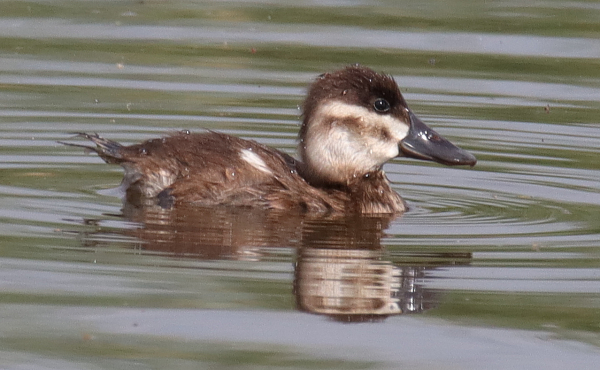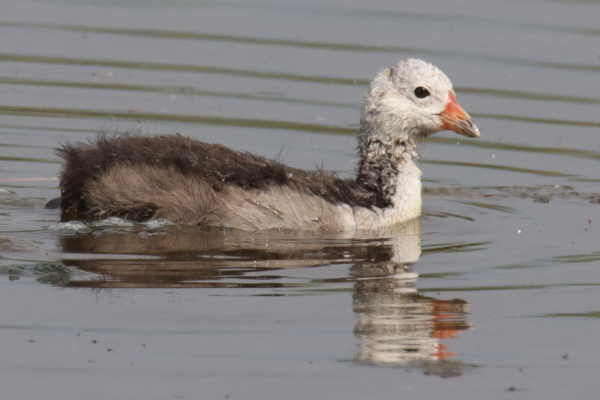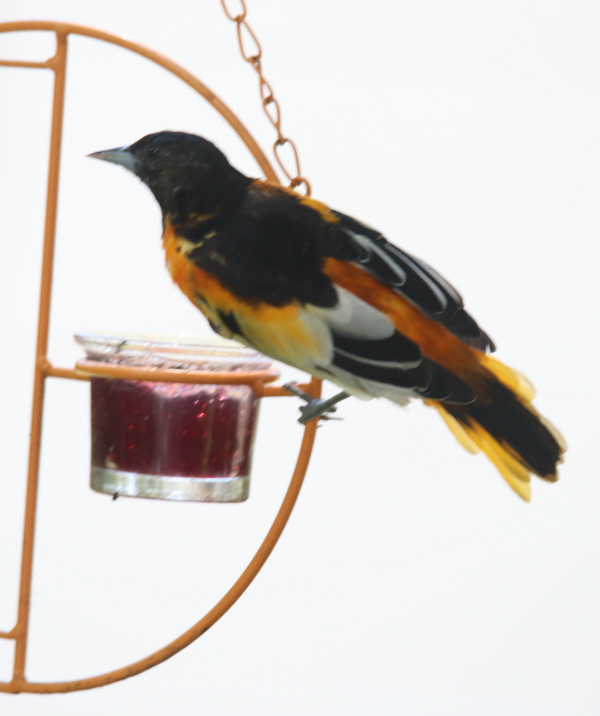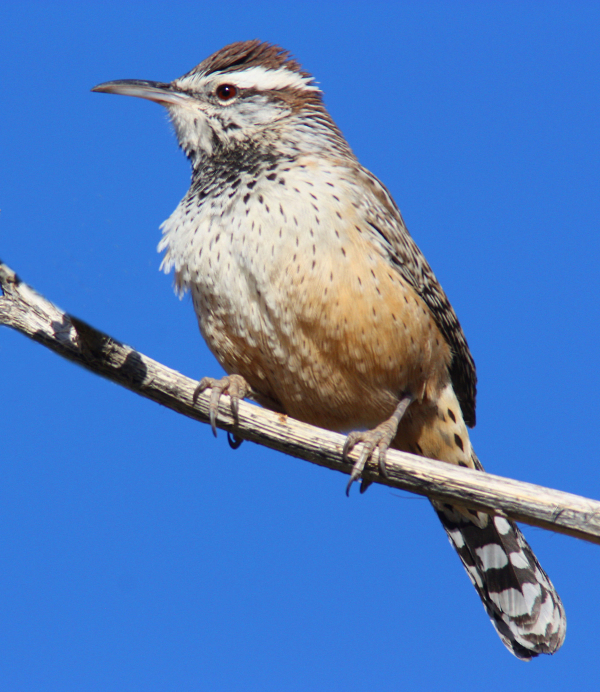
Somewhat comical looking, this very young Ruddy Duck duckling’s head and bill seem quite oversized compared to its small body. Even when they are this young, downy Ruddy Ducks dive enthusiastically underwater for food.

Can you identify this bird? Many field guides fail to provide good coverage of the variety of plumage changes as young birds mature and molt; case in point, a young American Coot.

After sighting the partial-albino adult male Baltimore Oriole 3 days in a row, a second feeder visit Monday provided a chance to take this documentary photo that shows some of the new wing feathers and the varied length of its new tail feathers.

Among the variety of shorebirds observed and photographed at Charo Marsh last week was a Spotted Sandpiper.
|
While birding the variety of wetlands east of Bismarck last Thursday, I stopped to view Ruddy Duck ducklings as they were swimming and diving in an open pond surrounded by a vast area of tall cattails. Although I observed 3 different sizes of the cute little guys spread across the pond, only the 6 smallest Ruddy ducklings were associated with an adult female. As I watched the Ruddys, a number of young American Coots were also active, and it was interesting to see the varied amount of white feathers on their head and neck, even among members of the same brood.
My next stop was Dogtown Marsh, which I hadn’t visited for a couple weeks, creating an added anticipation about what duck broods would be present. First up was a new brood of 9 downy Redheads with a hen, with a familiar brood nearby – the brood of 8 Canvasbacks I’ve been monitoring during July. In fact, photos of the adult female and her ducklings illustrated 2 consecutive Editor Afield articles in the July 19th and July 12th issues. Thursday, while they were positioned close to the road, I photographed them again to document their considerable growth during the 15 days that passed since my last photos. And that’s when I noticed something different about the ducklings, something beyond their obvious larger size and new plumage.
Some of the ducklings didn’t look quite right as I reviewed my photos and magnified some on the LCD monitor screen on the back of my camera; it suspiciously looked like some of the ducklings may not be Canvasbacks! The closer I looked the more likely it seemed that only 3 of the 8 ducklings were young Canvasbacks. The rest? They were Redheads! How did that happen you may ask? For a larger format photo than I can provide with this article, and for the explanation of how Redhead ducklings were present in this female Canvasback’s brood, I refer you to the first of 2 Bird Photography features in this issue, entitled “Canvasback Brood?”
White-winged Oriole Action!
Friday afternoon, just as I was about to prepare for a local birding drive, I heard an oriole chatter and looked up to see the white-winged male Baltimore Oriole dip its beak into the jelly jar on my oriole feeder. I carefully reached for my binoculars with the hope of getting a closer look at the progress of its summer molt, which I saw had progressed quickly since I last viewed this unique partial-albino oriole 7 days earlier. Its tail feathers looked to be about two-thirds their eventual full length, its wing feathers including primaries, secondaries, and coverts looked similarly two-thirds grown, and even the feathers on its nape and body looked almost completely replaced. The oriole flew to a low branch on the adjacent elm tree, wiped its beak clean, then took flight. I hoped it would return soon!
While editing some photos Saturday a bit after noon I looked up to see the white-winged Baltimore Oriole again, perched on the shepard’s crook above the jelly feeder, wiping jelly from its beak, having already eaten, and then it flew off. Three minutes later, another adult male Baltimore Oriole flew in to eat jelly, this one with new outer tail feathers growing in about half as long as its old central tail feathers. That normally plumaged male represents the only Baltimore Oriole I’ve seen in about 3 weeks besides the white-winged wonder – interesting – and it flew away in the opposite direction of the white-wing.
Ha – Then Sunday, there it was again, for a second consecutive noon-time visit. The white-winged Baltimore Oriole was already feeding, so this time I reached for my camera to try to get a photograph to document its molt, even in the harsh midday sunlight. The chance of a better photo increased as the oriole finished sampling jelly and took the short flight to the low branches of the adjacent elm tree. Indeed, the photos were better as the oriole hopped from branch to branch, but it didn’t turn to show its left wing where the white feathers are concentrated. A look at my photos indicated the tail feathers were close to being full length; the wing feathers looked pretty good, but it was hard to tell, and some breast feathers were still missing. As the oriole flew off I hoped for a quick return – again.
Then, as I was finishing writing the above paragraph, an hour later almost to the minute, there it was! The white-winged oriole was back! And with my camera ready and waiting, I tried to photograph it on my oriole feeder – and this time some images worked out pretty well – well enough to share with you so you can see the varied lengths of the tail feathers, and some of the white feathering on its wing that make it such a unique bird. That quick episode really jazzed up my adrenaline level, and I hoped he would become a regular visitor that day, this week, and as long as possible. After all, my only reliable oriole visitor for weeks has been the female Orchard Oriole that has been growing new tail feathers herself.
My other backyard event has been the ripening of the abundant chokecherries in my yard, creating an almost constant activity level by foraging American Robins. The action continued through the week, and although the berries are steadily dwindling, robins were abundant as they foraged throughout the grove of low chokecherry trees yesterday (Tuesday).
As reported a week ago, after a couple sightings of an adult male Yellow Warbler, last Tuesday I also sighted a fledgling near my feeding station. Similar sightings of fledgling Yellow Warblers continued thru Thursday, one in particular hunting bugs on each of the feeding station feeders, as well as the lower ash tree branches, sumac leaves, and chokecherry bramble. It was hard to say how many individuals were on hand, but I did see 2 and 3 fledglings at once. Then, as I was putting the finishing touches on this issue Tuesday, a fledgling female Hairy Woodpecker appeared on the trunk of the elm tree adjacent to my feeding station. After a moment she confidently moved onto my hopper feeder, selected a seed, and flew off. Quick stop, but the first of many I hope. It’s always fun to get surprises like that.
Beyond My Yard
In the field, I visited many of the area hotspots and took birding drives I frequent in the area, but the birds I observed added no new insights or new species among them. I frequented Charo Marsh, the hottest of my hotspots lately, but while the number and variety of shorebirds changes a bit day to day, over the span of the week the species composition on hand stays relatively constant. Although there are only 1 or 3 or 5 individuals of a given species, I get a kick out of observing and photographing Long-billed Dowitchers, Pectoral Sandpipers, White-rumped Sandpipers, Least Sandpipers, a Stilt Sandpiper, and Spotted Sandpipers, along with Greater and Lesser Yellowlegs and Wilson’s Phalaropes, but the Semipalmated Plovers haven’t been photographically cooperative to date, staying beyond photo range.
Numbers of newly hatched duck broods continue to appear on the edges of area wetlands, including new Gadwall broods, Blue-winged Teal, Ruddy Duck broods, Mallards, Northern Pintails, and Redhead broods. It’s certainly been a productive July for ducks and many other nesting birds. As we enter August, it will be interesting to see the changes among the avifauna as the nesting season fades, as young birds mature, and as migration expands. It’s exciting to go birding when time and weather permits, and I hope you enjoy this period with a few avian surprises to keep you excited and searching for more.
Article and photos by Paul Konrad
Share your bird sightings and photographs at editorstbw2@gmail.com